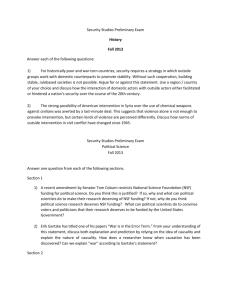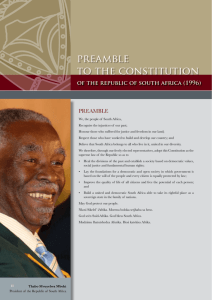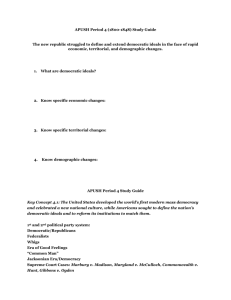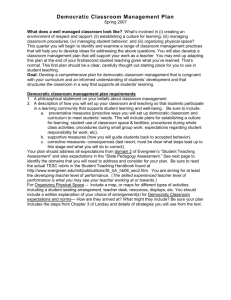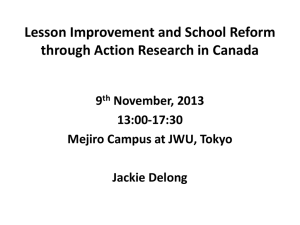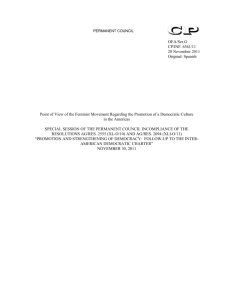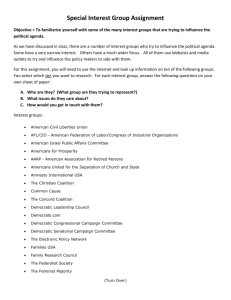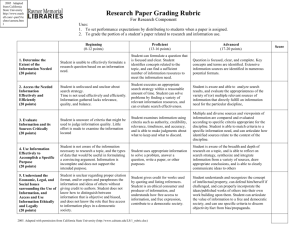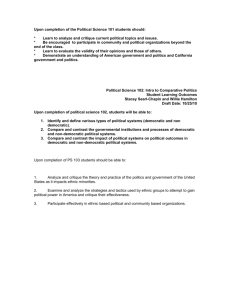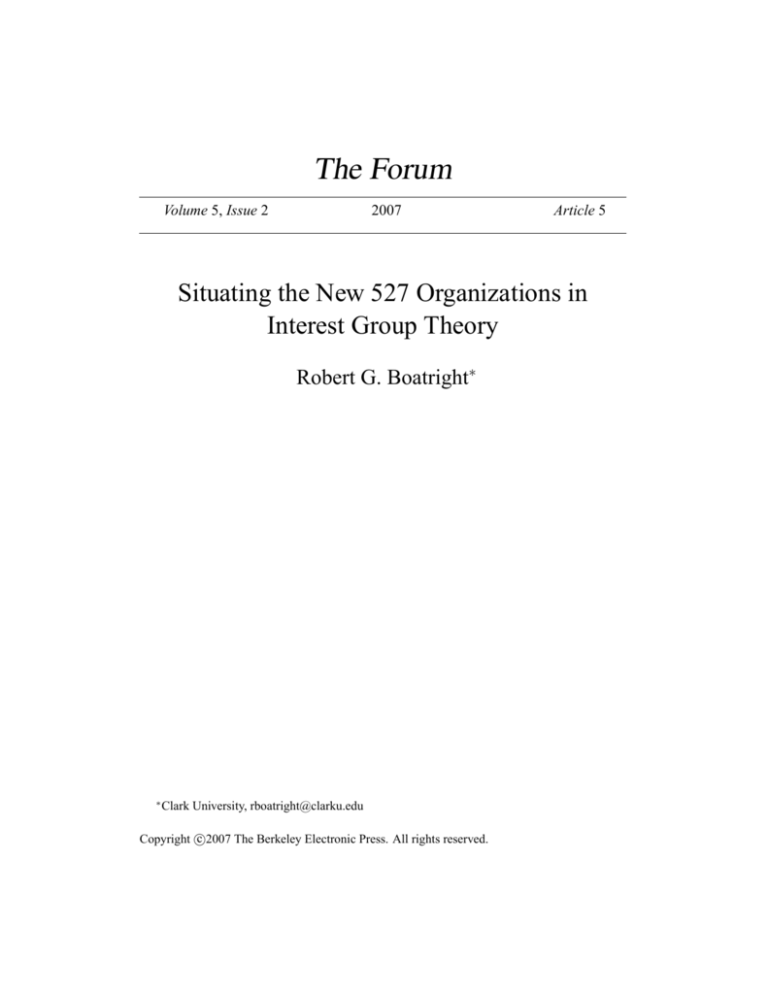
The Forum
Volume 5, Issue 2
2007
Article 5
Situating the New 527 Organizations in
Interest Group Theory
Robert G. Boatright∗
∗
Clark University, rboatright@clarku.edu
c
Copyright 2007
The Berkeley Electronic Press. All rights reserved.
Situating the New 527 Organizations in
Interest Group Theory∗
Robert G. Boatright
Abstract
This article seeks to reconcile the activities of several of the groups organized during the
2004 election cycle under section 527 of the Internal Revenue Code with existing theories of party
and interest group behavior. While 527 groups have frequently been categorized as extensions of
traditional advocacy groups or party networks, I argue that existing theories do not account for the
functional differentiation between these groups. This functional differentiation marks a relatively
unprecedented development in American interest group politics. However, the highly partisan
nature of the 2004 election and the limited appeal of these groups either to party donors or to a
broad base of interest groups may indicate that such groups will not endure or play as prominent a
role in 2008 as they did in 2004 even absent changes in FEC rules.
KEYWORDS: 527 groups, interest groups, 2004 elections
∗
Robert G. Boatright is an Assistant Professor of Government at Clark University. He is the author
of Expressive Politics: Issue Strategies of Congressional Challengers (Ohio State University Press,
2004), and is a coauthor of a forthcoming book on the evolution of interest groups’ campaign
strategies during the Bush Presidency. An earlier version of this paper was presented at the 2006
meeting of the Northeastern Political Science Association. The author thanks Richard Skinner,
Steve Weissman, and Michael Malbin for their comments or assistance.
Boatright: Situating the New 527 Organizations in Interest Group Theory
1
Long before the Bipartisan Campaign Reform Act was implemented,
politicians and interest group leaders predicted that the legislation would abet the
growth of new “quasi-party” organizations organized under Section 527 of the
Internal Revenue Code. Indeed, following the 2002 election, several new political
organizations were formed, and many of these organizations promised to raise as
much as $100 million. These groups adopted names that gave little indication of
the issue focus, the partisan leanings, or the membership base of the groups. Most
of these new organizations, however, dedicated themselves to working towards
the victory or defeat of President Bush in the 2004 election. Currently, these
groups stand in a sort of legal limbo – many have disbanded, and government
watchdog groups have successfully argued that some of these groups’ activities
are in violation of federal campaign finance laws.
The development of these groups struck many observers as either surprising
or disturbing, but they were in fact part of an evolution from the group and party
activities of 2000 – an evolution which will continue in 2008. Knowing what
exactly these groups are is important in understanding how American campaign
politics has changed during this decade. On the one hand, there is much evidence
to suggest that these groups were well embedded in the networks of each party
(see Skinner 2005). Yet these organizations nether can nor could have replaced
traditional party functions. The six national party committees all raised enough
money in 2004 to match, or even exceed, their combined soft and hard money
spending in past election cycles (Corrado 2006). By declining public matching
funds, both President Bush and John Kerry were also able to substantially exceed
the spending of previous presidential candidates. So from a financial angle, there
was not as much money to replace as some might have expected. In addition,
these groups did not duplicate party functions – they did not make direct
contributions to candidates or engage in any of the traditional party activities. On
the other hand, while these groups are separable from the parties, they do not
necessarily fit the mold of traditional interest or advocacy groups, either. They did
probably draw some large contributions away from advocacy groups, but they do
not have dues-paying members, they do not lobby, and they do not have, or seek,
an issue niche in the manner that advocacy groups do. While many of these
organizations drew their funding from other interest groups, it is difficult to argue
that they are functionally similar to advocacy groups.
In this article, I explore how one might situate these organizations within
traditional theories of interest groups and political parties. That is, which set of
theories might we draw upon to predict the political behavior of 527 groups? In
order to address this question, it is also necessary to ask two sub-questions. First,
what does the formation of these organizations mean (or what could it have
meant) for group theory? Many contemporary analyses of interest groups have
drawn attention to the dominance of business groups, or the dominance of single-
Published by The Berkeley Electronic Press, 2007
2
The Forum
Vol. 5 [2007], No. 2, Article 5
issue advocacy groups, and some of these theories have linked the current
constellation of groups to trends in citizen participation in politics. The distinctive
features of these organizations can lead us to address descriptive and normative
arguments about the role of groups and parties in American elections. And
second, why have these groups primarily been a phenomenon of the political left?
Why have conservatives failed to form rival organizations?
In regards to the first question, I seek here to disentangle the structure of these
groups from their intent. On one level, this may appear to be a semantic
distinction – if a group that raises money under a particular section of the tax code
or that is subject to particular regulations may be granted a certain designation, it
may be said to be an interest group regardless of what it is trying to do. On the
other hand, however, the leaders of many of these groups emphatically denied that
they were seeking to supplant the parties, or to perform traditional group
functions, and justified their groups’ activities according to their ability to do
what groups or parties cannot do. Ultimately, then, these groups’ leaders made
appeals to donors based primarily on what the groups could do, and only
secondarily on what they stood for. We are used to seeing interest groups and
political parties as broad organizations that engage in several activities in pursuit
of well-defined goals. For 527 groups, this arrangement is reversed – they seek to
engage in singular activities in pursuit of only vaguely-defined goals.
In regards to the second question, I shall argue here that these organizations
represented an attempt at political learning by Democratic partisans. Many studies
of the broader political trends of the past two decades have noted that individual
“post-materialist” causes are ably represented by liberal advocacy groups such as
the Sierra Club, the NAACP, or NARAL, but that there are few large
organizations on the left that have undertaken to advance a broader economic
message. The political right in the United States is comprised of fewer single
issue organizations, but conservative issues have been advanced within the
Republican Party, within conservative think tanks, and by individual issue
entrepreneurs. The formation of these new organizations represented a belated
effort by liberals to form a similar complex of groups, and the fact that these
groups sought functional niches – that is, for one group to concentrate on
advertising, for another to concentrate on voter registration and mobilization, and
so on – represented a new development in the politics of the left. These groups
formed as 527s because of the state of politics and of campaign finance law in
2004, just as conservative groups adopted different methods because of the
circumstances under which they developed.
The sentiment on the left that liberals needed to form broader coalitions and a
broader economic message has been a staple of Democratic strategists’ rhetoric
for several years (see, e.g., Greenberg 1995, Judis and Teixeira 2002). Yet most
of the leaders of these groups were reluctant to court public scrutiny, and thus it is
http://www.bepress.com/forum/vol5/iss2/art5
Boatright: Situating the New 527 Organizations in Interest Group Theory
3
difficult to know how extensively this strategy had been thought out by the
individuals leading these organizations. Whether these adaptations were made
with a broader political strategy in mind, or whether they were an immediate
reaction to BCRA and to these groups’ aspirations to unseat President Bush is
unclear. In addition, legal hurdles and organizational hurdles appear to have
prevented many (but not all) of these groups from becoming enduring
organizations. Even if these groups are not hobbled by new rulings, 2006 has
shown that they are not necessarily able to mobilize resources effectively in
midterm elections, and they may also be handicapped in doing so under a
Democratic President. This article may, then, be speculation about events that
could have come to pass, but did not.
At a minimum, however, these often maligned groups do (or did) represent a
new group “type” in political campaigns, and as such they are worthy of study. In
order to advance my argument, a synopsis of the political background of these
groups is necessary. Thus, I first provide a description of the 527 tax status and of
the major new organizations that filed as 527s between 2002 and 2004, and I seek
to provide a rough typology of 527 groups. I describe the immediate causes of
these groups’ formations, the expectations of existing group leaders about what
these groups would do, and the political and legal conflict over these groups’
activities. Second, I explore what I term the “deeper causes” of these groups’
formations, focusing on theories of the liberal/conservative balance of power in
American politics and with particular attention to the Democratic tilt among 527
groups. Third, I explore traditional arguments about the features of political
parties and interest groups, and how these features determine an organizations’
incentives and activities. I compare the structure and activities of these groups to
these theories in an effort to seek to classify these groups and draw predictions for
the 2008 cycle and future cycles from their behavior. And fourth, I note areas in
which these groups diverge from our basic understandings of organizations’
political activities.
Background
Section 527 of the Internal Revenue Code covers political party organizations,
political action committees, and other organizations that engage in political
activities. Groups that are not party committees or PACs are not required,
however, to file regular disclosure reports with the Federal Election Commission;
instead, they file “periodic” reports with the IRS. 527 groups existed well before
the passage of BCRA, and until 2001 they were not required to disclose their
donors at all. Table 1 shows the diversity of 527 groups. Many veteran business or
advocacy groups (such as the Sierra Club or the National Association of Realtors)
maintain a connected 527 fund. Other groups, while in name distinct from
Published by The Berkeley Electronic Press, 2007
4
The Forum
Vol. 5 [2007], No. 2, Article 5
existing groups, drew an overwhelming majority of their money from one patron
– this was the case with the Chamber of Commerce’s November Fund and
organized labor’s Voices for Working Families. MoveOn.org, which is often
mentioned by critics of the new 527 organizations, has actually existed since
1998, and in many ways functions like a traditional advocacy group, bundling
contributions and operating its own PAC. Other organizations listed among the
top 527 committees include several groups that are clearly related to the parties,
including the Democratic Legislative Campaign Committee, the Republican
Leadership Council, GOPAC, and the New Democrat Network. Finally, the 527
with the second-highest total receipts, Joint Victory Campaign 2004, is in fact a
fundraising committee for two other 527s, America Coming Together and the
Media Fund. Similar, smaller organizations, such as Democratic Victory 2004, are
also listed among the largest 527 groups.
Table 1 shows all 527 groups with receipts of more than $2 million in 2004. If
one winnows this list according to the above description – that is, removing
connected 527 funds, groups overwhelmingly reliant on one patron, those linked
at least in name to the parties, and those which serve as fundraising vehicles for
other groups, we are left with nine organizations left among the 27 largest 527s.
These organizations are listed in bold print in the table. Within this set, there is
one distinction that stands out – whether the group was formed for an ongoing
purpose, or whether it was intended to focus primarily on one candidate or one
election. Briefly, the groups are as follows:
America Coming Together (ACT) was directed by former AFL-CIO political
director Steve Rosenthal and EMILY’s List president Ellen Malcolm, but it did
not draw heavily on the resources of either group. ACT’s stated purpose was to
contact voters in battleground states. It grew out of an earlier, labor-funded 527
group, the Partnership for America’s Families, which dissolved amid infighting
among its union supporters (Edsall 2003, Cillizza 2003, Bresnahan 2003).
Although ACT leaders spoke of the role that the group could play in the 2006
elections – for instance, ACT had compiled voter lists that it felt could be
effectively used in large states such as Ohio and Pennsylvania which had Senate
and gubernatorial elections – the group formally disbanded in early 2005.
Although it received between $7.5 million and $20 million from financier George
Soros, and as much as $20 million from Peter Lewis (the two gave to both ACT
and the Joint Victory Campaign, which in turn funded ACT), the group did solicit
smaller donations from individuals and groups, and (unlike many other 527
groups) sought to make its activities and fundraising fully visible to the public.
ACT maintained a free email list, and although it ceased operations in early 2005,
after the 2004 election the group sent out several emails indicating that it planned
http://www.bepress.com/forum/vol5/iss2/art5
Boatright: Situating the New 527 Organizations in Interest Group Theory
5
Table 1: 527 Organizations Active in the 2004 Elections With Receipts of Over $2 Million
Organization
Partisanship
Connected?
America Coming Together
Joint Victory Campaign 2004
The Media Fund
Progress for America
Democratic
Democratic
Democratic
Republican
No
No
No
No
Receipts
(in millions)
$78.65
$71.81
$59.39
$44.93
Patron or Largest Donor
Active in
2002?
No
No
No
No
Active in
2006?
No
No
No
Yes
George Soros ($7.5m)
Peter Lewis ($16.0m)
AFSCME ($2.1m)
AG Spanos Co.;
Ameriquest ($5.0m)
SEIU Political Education and Action Fund
Democratic
Yes
$41.00
SEIU
Yes
Yes
AFSCME 527 Account
Democratic
Yes
$22.14
AFSCME
Yes
Yes
Swift Boat Veterans and POWs for Truth
Republican
No
$17.07
Contran Corp ($3.0m)
No
No
MoveOn.org Voter Fund
Democratic
Yes
$12.52
MoveOn
No
Yes
New Democratic Network Non-Federal Account
Democratic
Yes
$12.22
NDN
Yes
Yes
Citizens for a Strong Senate
Democratic
No
$10.85
Herbert & Marian
No
No
Sandler ($8.55m)
Sierra Club Voter Education Fund
Democratic
Yes
$8.73
Sierra Club
Yes
Yes
Club for Growth
Republican
Yes
$7.86
Club for Growth
Yes
Yes
EMILY’s List Non-Federal
Democratic
Yes
$7.68
EMILY’s List
Yes
Yes
1199 SEIU Non-Federal
Democratic
Yes
$7.48
SEIU
Yes
Yes
Voices for Working Families
Democratic
Yes
$7.47
AFL-CIO
No
Yes
League of Conservation Voters 527 Fund
Democratic
Yes
$6.55
LCV
Yes
Yes
College Republicans National Committee
Republican
Yes
$6.37
College Republicans
Yes
Yes
AFL-CIO COPE
Democratic
Yes
$6.34
AFL-CIO
Yes
Yes
ClubforGrowth.net
Republican
Yes
$4.12
Club for Growth
No
No
Democratic Victory 2004
Democratic
No
$3.93
Ann Tenenbaum ($177,000) No
No
Laborers’ Political League Education Fund
Democratic
Yes
$3.67
LIUNA
Yes
Yes
National Association of Realtors 527 Fund
Republican
Yes
$3.21
Nat’l Ass’n of Realtors
Yes
Yes
November Fund
Republican
Yes
$3.15
Chamber of Commerce
No
No
Partnership for America’s Families
Democratic
No
$3.07
SEIU ($1.95m)
No
No
Grassroots Democrats
Democratic
No
$2.82
ATLA ($325,000)
Yes
Yes
Stronger America Now
Democratic
No
$2.79
Steve Bing ($252,217)
No
No
America Votes
Democratic
No
$2.62
Three donors at $250,000
No
Yes
Democratic
No
$2.54
A. Rapaport ($600,000)
Yes
Yes
21st Century Democrats
SMWIA Political Education League
Democratic
Yes
$2.16
SMWIA
Yes
Yes
Source: Adapted by author from Weissman and Hassan 2006, additional data from Center for Public Integrity and Center for Responsive Politics. Nonconnected,
ostensibly nonpartisan groups are listed in bold.
Published by The Berkeley Electronic Press, 2007
6
The Forum
Vol. 5 [2007], No. 2, Article 5
to continue. Much of the information gathered by the group appears to have been
transferred to Harold Ickes’s Data Warehouse Corporation for use in the 2006 and
2008 election cycles (Vandehei and Cillizza 2006; Green 2006).
The Media Fund was led by former Clinton administration official Harold Ickes,
Jr. As the name indicates, the Media Fund concentrated on television advertising
aimed at President Bush during the spring and summer of 2004. The Media Fund
was the outgrowth of discussions among Democratic Party leaders who believed
that the eventual Democratic Presidential nominee would be at a financial
disadvantage during the summer of 2004; Grassroots Democrats, an organization
designed to channel funds to state parties, was also an outgrowth of these
discussions (Weissman and Hassan 2006, 85). The Media Fund ceased operations
after the Democratic Convention, and it never sought to portray itself in as open a
manner as did ACT – its website contained little more than scripts of its
advertisements. The Media Fund was designed to complement ACT’s activities,
and in several instances it aired television advertisements aimed to coincide with
ACT mobilization drives or campaign appearances by John Kerry or President
Bush. Ickes became the leader of ACT after Rosenthal stepped down in late 2004.
Progress for America was the largest Republican-leaning 527 organization. It was
by far the largest advertiser among Republican non-party groups, spending an
estimated $26.4 million on advertisements and $44.9 million overall in 2004
(Phillips 2007). PFA was originally formed as a 501(c)(4) but shifted its activities
to a 527 organization in May of 2004 after it became apparent that the FEC would
not regulate 527 groups (Weissman and Hassan 2006, 88). Unlike the larger
Democratic organizations, PFA continued operating after the 2004 election. The
group received a steep FEC fine ($750,000), however, for illegally coordinating
its expenditures too closely with the Bush campaign (Phillips 2007). Following
this penalty, PFA shifted most of its operations back to its 501(c)(4) following the
FEC penalty (Weissman and Ryan 2007, 12).
Swift Boat Veterans and POWs for Truth arguably received funds in 2004 from a
broader base than did any of the other major 527 groups. That is, only $4.65
million of its funds – or only slightly more than one-fourth of its total receipts –
came from contributors of over $1 million. The group’s spokesman, Mike Russell
(2005), claimed that the average contribution was between $50 and $60. Swift
Boat Veterans was clear throughout the election that its intention was to discuss
John Kerry’s war record, that it had no intention of forming an enduring
organization. Russell argued after the election that “one of the more positive
developments of this cycle was that 527s allowed for citizen groups to step
http://www.bepress.com/forum/vol5/iss2/art5
Boatright: Situating the New 527 Organizations in Interest Group Theory
7
forward and mobilize very quickly, raise money, and spend resources as they see
fit.”
If ACT was geared towards mobilization and the Media Fund was geared towards
advertising, America Votes was a group whose goal was coordination. Apart from
$500,000 in seed money from individuals, America Votes was funded through
contributions of $50,000 or larger from five labor unions (AFL-CIO, the
American Federation of Teachers, the National Education Association, the
Service Employees International Union, and the American Federation of State,
County, and Municipal Employees) and several liberal groups (including ACT,
the Media Fund, NARAL Pro-Choice America, the Human Rights Campaign,
EMILY’s List, the Sierra Club, MoveOn.org, the League of Conservation Voters,
the American Trial Lawyers' Association, Planned Parenthood, People for the
American Way, and the Brady Campaign). The group was active in seventeen
different states; member groups shared polling, targeting, and candidate training
sessions. They divided states into geographic regions for voter contacting, and
coordinated their rapid response efforts. Part of the long-term goal of this effort
was to expand the voter files of these groups and fill in information on younger
voters for all of these organizations. Unlike the other large, left-leaning
organizations, America Votes remained quite active in 2006.
The two remaining large Democratic groups were far less visible. Citizens for a
Strong Senate drew 85 percent of its money from wealthy investors Herbert and
Marian Sandler; the group aired television advertisements in Senate races in six
states (Justice 2005). It was run by former staffers of Vice Presidential candidate
John Edwards (Weissman and Hassan 2006, 83). Stronger America Now raised
large contributions from long-time Democratic soft money donor Steve Bing and
from several prominent trial lawyers and trial lawyers’ firms. The group aired
television advertisements during the general election in the presidential race and
several congressional races.
Finally, 21st Century Democrats is the lone organization on this list that, while it
lists its party affiliation in its name, cannot be said to merely be a fundraising
vehicle for party interests. The group drew funds from traditional soft money
donors to the party or from those who had contributed substantial funds to other
left-leaning 527s; contributors included Soros, Linda Pritzker, and Peter
Buttenwieser. The group’s stated agenda, however, makes it clear that it seeks to
elect progressive Democrats, not merely to help the Democratic Party. 21st
Century Democrats also figured prominently in discussions surrounding the
creation of ACT and America Votes; the group was seen as a vehicle for
involving younger voters in 527 activities.
Published by The Berkeley Electronic Press, 2007
8
The Forum
Vol. 5 [2007], No. 2, Article 5
Two unsurprising factors appear in this list – first, there are no bipartisan
groups. Bipartisan groups tend to value access. For 527 groups sponsored by
established interest groups, there clearly was no expectation that the 527 spending
would increase the group’s access. 527s were likely viewed by these groups as a
supplement to more traditional activities, and this supplement was primarily
directed towards the group’s preferred party even if PAC contributions or other
activities were not directed exclusively in this fashion. For the free-standing 527s,
access was not pursued or expected at all.
Second, the relationship between donors and staff is somewhat ambiguous. It
is certainly not unprecedented for individual donors to place conditions on
contributions to existing groups, as the large individual contributions to Planned
Parenthood, NARAL, and the NAACP in 2000 illustrate, and groups such as these
would likely have received similar contributions in 2004 had the new 527s not
emerged. But it would be difficult to argue that any of the larger advocacy groups
are primarily the creation of one donor or a small group of donors. Some
advocacy groups are largely the domain of one individual, but they tend to be
recognized as such. In contrast, much of the raison d’etre of the newer groups
seems premised on the desires of individual wealthy contributors. In particular,
groups like Citizens for a Strong Senate seem to be little more than vehicles for a
wealthy donor; even ACT, with larger funds at its disposal, made its decisions
about which states to focus upon based on the contributions of Soros and Lewis.
Several of these groups appear to be more than merely conduits for one
individual, but few seem entirely independent of a relatively small number of
donors. As Weissman and Ryan (2007) interpret the new FEC rules governing
527s, however, groups dependent on a small number of donors are likely to
continue to be active in 2008 while those with a broader base, and hence a more
overtly partisan means of soliciting donations, will not be able to operate as 527s.
A third factor, perhaps more surprising, is the lack of duplication of function
among these organizations. While the infrastructure of Democratic-leaning groups
appears to have been the result of careful deliberations among party elites, the
neat division of labor was clearly not a given, as the conflict over the Partnership
for America’s Future and among different labor unions showed. A parties-based
perspective might categorize the major Democratic groups as a logical division of
labor for those wishing to advance the party agenda; a more group-based
approach might, however, note that could have been competition among groups to
fill various functional niches. The conflict among labor groups did, for a time,
pose the possibility that more than one group would be active in the same states,
pursuing the same agenda but with different leadership. One component of the
resolution of the conflict over the Partnership was an agreement by the leaders of
Voices for Working Families that they would not be active in the same areas as
ACT in order to avoid just such duplication. It is certainly possible that, had
http://www.bepress.com/forum/vol5/iss2/art5
Boatright: Situating the New 527 Organizations in Interest Group Theory
9
President Clinton and others not taken a role in the development of ACT, there
would not have been as much coordination.
Finally, as noted above in the discussion of the Swift Boat Veterans, 527s are
ideally suited for quick mobilization, and in the case of groups that focus on
advertising, appear to be an easy means for those with an interest in a particular
election to play a role without creating much in the way of group infrastructure or
organization. This is, again, not without precedent – in several election cycles
prior to 2004 short-lived groups were formed with the intention of affecting
election results. These types of 527 groups were predicted before BCRA, and they
are hardly “groups” any more than those formed by the insurance or
pharmaceutical industries in 2000 and 2002 (Americans for Job Security for the
insurance industry, and Citizens for Better Medicare and the United Seniors
Association for the pharmaceutical industry) are groups. What remains, then, are
organizations like ACT, America Votes, and Progress for America – these groups
make appeals separate from the party and at least appeared during 2004 to be built
to last. The question, then, is what these groups are, exactly, in regards to existing
group theories.
Deeper Causes
One of the most significant characteristic of the crop of liberal 527 groups that
appeared in 2004 was their ability of the groups to pool group resources, to
engage in coalition activities that individual groups may not be capable of by
themselves. Collectively, these groups may be said to reflect an adaptation by
liberals to the conservative trend within American politics of the past twenty
years. Had this adaptation taken place earlier, these same groups might have
appeared in a different form, but the 527 classification gave them an effective
means of organizing to pursue their aims. As the Sierra Club’s Margaret Conway
noted before the election, organizations such as American Coming Together and
America Votes had been in the planning stages before BCRA, and in many cases
merely solidified informal relationships between groups (Conway 2004).
To situate these organizations within broader political trends, two different
accounts of the interest group politics of the past two decades are necessary. In
The New Liberalism, Jeffrey Berry argues that citizen groups, most of which tend
to adopt left-of-center positions, have been singularly successful in achieving
their policy aims and in amassing influence and credibility on Capitol Hill. Berry
documents this claim by comparing interest group lobbying, committee
testimony, and other legislative activities from the 1960s through the early 1990s.
Berry credits organizations such as the Sierra Club, Common Cause, and the
NAACP with shifting American public opinion, and the congressional agenda,
from material issues to “quality-of-life concerns” (Berry 1999, 2). Berry notes
Published by The Berkeley Electronic Press, 2007
10
The Forum
Vol. 5 [2007], No. 2, Article 5
that competition between these groups for members has led each group to adopt a
particular set of signature issues. This squares with the argument that groups seek
distinct policy “niches.” These groups’ activities have been primarily in the
legislative arena, however; they have not concentrated their efforts on elections to
the degree that conservative organizations have.
Conservative organizations, such as the Moral Majority and the Christian
Coalition, have, according to Berry, had some political success but have not been
able to clearly differentiate themselves from each other, from their individuals
leaders, or from the Republican Party. These groups share the “post-materialist”
focus of liberal groups but prefer to work in the electoral arena rather than in the
legislative arena. Issue entrepreneurs such as Ralph Reed, Grover Norquist, and
Gary Bauer are far more visible as individuals than are the groups they lead. For
Berry, liberal advocacy groups represent the institutionalization of the movement
politics of the 1960s, while conservative advocacy groups represent a
countervailing social movement, but one without a similar institutional structure.
In an effort to achieve influence within the Republican Party, these groups have
forgone the construction of strong lobbying arms. They have instead sought to
achieve power by working within the Republican Party and declining to press
their issues when doing so disadvantages the party.
Berry cautions in the conclusion to his book that one should not assume that
because liberal advocacy groups have prevailed on many policy issues, a broader
liberal agenda has prevailed. Unions, he notes, have failed to prevent the decline
in their membership, failed to prevent NAFTA and other free trade agreements,
and have generally not been seen as sources of expert advice in the manner that
advocacy group analysts have. For Berry, liberal groups have been successful in
preserving environmental protection laws, in preventing further restrictions on
abortion, and in expanding civil rights and consumer rights protections. Yet they
have not linked these issues in a systematic way, nor have they forged links with
traditional notions of economic liberalism or with a consensual Democratic
agenda. The narrow niche focus of these groups has led to legislative success, but
not to electoral success.
If Berry sees the glass as half full for liberals, Mark Smith sees the same glass
as half empty. Smith (2007) notes that the issue appeals of liberal groups tend to
be relatively narrow, and that the left lacks the infrastructure of think tanks,
foundations, and so on that Republicans created, and that can craft a broad
economic message – there are no liberal equivalents to, for instance, the Heritage
Foundation. Public receptiveness to an economic message is “broad but thin” –
that is, the public cares about economic issues, but there are few narrow policy
niches from which advocacy groups can craft such a message. Voluntary
membership groups, in particular, do not form around economic messages. For
Smith, the constellations of groups on each side of the political spectrum work to
http://www.bepress.com/forum/vol5/iss2/art5
Boatright: Situating the New 527 Organizations in Interest Group Theory
11
the disadvantage of liberal economic interests. There are, effectively, two types of
liberalism, and they do not complement each other. As part of the “New Voice”
Platform, the AFL-CIO’s John Sweeney had sought to expand the AFL-CIO’s
coalition work with advocacy groups (see Gerber 1999, 86; Francia 2006, 7; Dark
1999, 183), and labor had sought to downplay its role as the largest group in such
coalitions. Likewise, the networks among advocacy groups with different
agendas, in 2000 and before, show a willingness on the part of such organizations
to share ideas (see, e.g., Boatright, Malbin, Rozell, Skinner, and Wilcox 2003 for
details on the NAACP and the Sierra Club). But the 2004 election represented, for
liberal groups, a movement beyond this.
If one wishes to view these two arguments through a normative lens, it must
be noted that the losers in both arguments are broadly based, participatory
organizations. On the left, labor unions are by far the largest organizations, yet
they are left out of both arguments. Their declining numbers and their lack of
policy analysis credibility make labor unions unlikely vehicles for successful
political advocacy. The largest liberal advocacy groups, such as the Sierra Club,
still have fewer than one million members, a number large enough to fund skilled
lobbying but too small to wield electoral clout simply by virtue of the number of
members who can be mobilized to vote. On the right, a group like the Christian
Coalition can boast a larger membership, but cannot necessarily boast of a skilled
lobbying effort. And neither side would appear to be able to successfully bring
about the type of citizen participation that political scientists such as Putnam
(2000) and Skocpol (2003) have argued is necessary.
Hence the paradox of the pooling of resources by liberal groups in the new
527s and the emphasis on grassroots mobilization by many of these groups. A
group like America Votes can enable Washington-based advocacy groups to pool
their resources in order to reach a broader swath of the public in a more personal
manner, and the fact that groups with diverse issue niches have joined together
may signify an effort to craft a larger issue message. And a group like America
Coming Together could reach more people in a face-to-face manner than had been
done by interest groups in the past. These groups sought to stimulate participation,
but they were not in and of themselves participatory, and the reluctance of many
of these group leaders to court publicity made them unlikely vehicles for
furthering participation in the long run.
These organizations gave the appearance, however, of being potential building
blocks for a strikingly different group infrastructure than in the past. It is difficult
to know whether this infrastructure was designed to address the structural issues
Berry and Smith raise or merely a convenient financial arrangement. If one
considers, for instance, the Media Fund, ACT, America Votes, the 501(c)(3)
Center for American Progress, the 501(c)(4) Campaign for America’s Future, and
the state- and local-election focused 527 Progressive Majority, it is clear that
Published by The Berkeley Electronic Press, 2007
The Forum
12
Vol. 5 [2007], No. 2, Article 5
these groups each sought a functional niche – one handled advertising, another
handled voter mobilization, another brokered advocacy groups’ discussions,
another served as a left-leaning think tank, and another focused on developing a
“farm team.” These differences render these groups unique in that they do not
square with previous understandings of interest groups or political parties, and
they have implications for the behavior of these organizations. Republicans could,
perhaps, have attempted something similar, but they did not need to in 2004; they
already had a complex network of similar organizations in place, perhaps due to
their minority status in Congress during the 1970s and 1980s.
Neither Fish nor Fowl: Classifying 527s
Interest Group Arguments
Political scientists have long endeavored to extrapolate interest group behavior
according to particular group characteristics. As Baumgartner and Leech (1998,
22-23) point out, however, there is no commonly accepted definition of an interest
group. They approvingly cite Salisbury’s (1984) contention that an adequate
definition of an interest group must be expansive enough to cover every “active
unit . . . that engages in interest-based activity relative to the process of making
public policy.” According to this definition, 527s are arguably interest groups.
Other, more restrictive definitions, however, would place them, at the least, in
a separate category from most interest groups. Baumgartner and Leech go on to
list ten different definitions for interest groups, of which these 527s fill only three.
These groups do not represent clearly defined social or demographic groups; they
are not membership organizations; they are not social movements; they do not
employ lobbyists; they do not have affiliated PACs; they do not participate in
legislative or rule-making hearings; and they do not have relationships with
corporations or government institutions. They are arguably comprised of
individuals with similar beliefs (that is, they do have a political interest, albeit a
diffuse one), they are coalitions of different organizations, and they do feature
individual political entrepreneurs, despite the low visibility of many of these
individuals in the 2004 elections.
To put matters more broadly, if we consider these organizations interest
groups, we must ask what their “interest” is. Each group took a clear partisan
stance in the 2004 elections, but they did not seek to establish an issue agenda per
se. The ACT promotional material, for instance, claimed that ACT’s goal was to
build “the largest voter mobilization project in American history. Knocking on
doors and speaking the truth, ACT canvassers are laying the groundwork to defeat
George W. Bush and elect Democrats in federal, state, and local elections in
2004” (America Coming Together 2004). The group’s web site did list issues of
http://www.bepress.com/forum/vol5/iss2/art5
Boatright: Situating the New 527 Organizations in Interest Group Theory
13
concern to the group – including the deficit, health care, and the war in Iraq – but
the section on issues was simply a compilation of media quotes, and was much
smaller than the pages explaining what ACT planned to do in the 2004 election.
Similarly, the Media Fund claimed on its website that its agenda was to present a
“progressive message” and to “ensure that a Democratic message focused on
issues of concern to all Americans will be on the air during the critical period
between the end of the primaries and the Democratic Convention.” Smaller
groups adopted similar rhetoric; Environment 2004 claimed on its website that the
difference between it and established environmental groups is that it was the only
environmental organization committed to only supporting Democratic candidates.
With the exception of America Votes and the 527s that are or were
exclusively supported by individual unions, these groups relied upon large,
individual donors (as Table 1 shows). It is difficult to fully describe these donors
as members. A patron may play a major role in setting the group’s agenda, but
because of the dominant role a patron plays, he or she is not the sort of member
that, for instance, a dues-paying member of an advocacy group is. If the patron
departs, the group is defunct. In the case of smaller donors – as, for instance, is
the case with smaller donors to ACT – donors may be recruited based on ties with
the patron or with an understanding of the function the group is to fill. That is,
these donors are largely dispensable for the group, play little or no role in setting
group priorities, and would appear to be seeking little in the way of benefits –
even less, perhaps, than a donor to a cause-oriented group might. 501(c) groups
may depend heavily on large donors as well – as the Sierra Club’s Carl Pope
suggests, limitations on large donations would irreparably harm many traditional
advocacy groups (Weissman and Ryan 2006) but they would not put these groups
out of business.
There are two basic elements missing, then. First, the lack of a well-defined
interest makes it difficult to provide a benchmark for outsiders (that is, those who
do not run the groups or provide their funds) to measure group success, and this
would also seem to influence the organizations’ long-term prospects. Had John
Kerry won the 2004 election, it might have been difficult for these organizations
to convert their efforts towards other issues, and it does not appear that many
groups successfully adapted their strategies to the 2006 midterm elections. The
lack of an issue agenda makes evaluating subpresidential candidates and races of
importance problematic, and few other elections seem likely to generate as much
fervor as the 2004 presidential race. Indeed, some of the most prominent
nonconnected 527 organizations in 2006 were state- or election-specific, as shown
by the activities of Softer Voices (in the Pennsylvania Senate race) and Too
Extreme for Colorado (in the Colorado 7th District House race). In both instances,
the 527 groups appear largely to have been vehicles of one donor or a small
number of donors. As Table 2 shows (again, with the nonconnected, nonparty
Published by The Berkeley Electronic Press, 2007
The Forum
14
Vol. 5 [2007], No. 2, Article 5
Table 2: 527 Organizations Active in the 2006 Elections With Receipts of Over $2 Million
Organization
Partisanship
Connected?
Service Employees International Union
America Votes
Democratic
Democratic
Yes
No
Receipts
(in millions)
$25.1
$14.4
EMILY’s List Non-Federal
Club for Growth
Progress for America
Int’l Brotherhood of Electrical Workers
September Fund
Economic Freedom Fund
America Coming Together*
College Republicans National Committee
Laborers’ Political League Action Fund
Americans for Honesty on Issues
GOPAC
Gay and Lesbian Victory Fund
United Food and Commercial Workers’ Union
Majority Action
Democratic
Republican
Republican
Democratic
Democratic
Republican
Democratic
Republican
Democratic
Republican
Republican
Democratic
Democratic
Democratic
Yes
Yes
No
Yes
No
No
No
Yes
Yes
No
Yes
Yes
Yes
No
$11.8
$7.2
$6.2
$5.5
$5.2
$5.0
$4.5
$3.7
$3.7
$3.0
$2.9
$2.2
$2.2
$2.2
Patron or Largest Donor
SEIU
SEIU ($2.2m);
George Soros ($2.1m)
EMILY’s List
Club for Growth
Chartwell Partners ($5.0m)
IBEW
SEIU ($800,000)
Perry Homes ($5.0m)
SEIU ($2.75m)
College Republicans
LIUNA
Perry Homes ($3.0m)
GOPAC
John Stryker ($750,00)
UFCW
Adam Rose ($500,000);
SEIU ($450,000)
AFSCME ($350,000)
SMWIA
Active in
2002?
Yes
No
Active in
2004?
Yes
Yes
Yes
Yes
No
Yes
No
No
No
Yes
Yes
No
Yes
Yes
Yes
No
Yes
Yes
Yes
Yes
No
No
Yes
Yes
Yes
No
Yes
Yes
Yes
No
Grassroots Democrats
Democratic
No
$2.0
No
Yes
SMWIA Political Education League
Democratic
Yes
$2.0
Yes
Yes
* ACT disbanded in early 2005.
Source: Center for Responsive Politics. Totals for some groups are aggregate figures for multiple 527 organizations. Table includes only groups focused on federal
elections.
Nonconnected, ostensibly nonpartisan groups are listed in bold.
http://www.bepress.com/forum/vol5/iss2/art5
Boatright: Situating the New 527 Organizations in Interest Group Theory
15
groups in bold), there were indeed fewer 527 groups active in the 2006 election
cycle, and most of those that were not directly connected to a PAC were still
heavily dependent on unions (on one union, actually, the SEIU). The only new,
truly nonconnected 527s were two groups funded entirely by Texas homebuilder
Robert J. Perry: Americans for Honesty on Issues and the Economic Freedom
Fund, both of which ran attack advertisements against Democratic candidates.
Second, the lack of a mass membership base renders these organizations
somewhat autonomous – they do not need to provide benefits to their members in
the same manner that traditional interest groups do, nor do they need to establish
policy expertise or political clout. The limited fundraising base ensures that those
who do fund the organization may be privy to information about group activities
that the public does not receive, and they may be more amenable to appeals for
funding than one would expect a more results-oriented group member to be. It
also provides flexibility to the group – with no mandate to talk about any
particular issues, it can change focus according to prevailing political trends.
Although I note above that Moveon.org is in many ways a more traditional
interest group, its evolution from a group focused on the Clinton impeachment in
1998 to its focus on the economy and the Iraq War in 2004 and beyond shows that
it, as well, was far more able to adapt than a more issue-specific advocacy group
could have been. Overall, however, these groups resemble the portrait of political
participation painted by E. E. Schattschneider (1975) in The Semi-Sovereign
People – some aspects of political participation may be pursued by groups that are
not particularly participatory in and of themselves, and a mass membership base
is hardly necessary for a group which seeks to encourage participation in politics
more generally.
Parties Arguments
If 527 groups are not quite traditional interest groups, though, they also fit
uncomfortably within the rubric of political parties. According to John Aldrich’s
definition, political parties are first and foremost a creation of politicians;
politicians create parties to pursue their own ends (Aldrich 1995, 4). As noted
above, politicians and activists of good standing in their parties did have a hand in
the creation of several of the larger 527s. Politicians, of course, create entities
besides parties – the most notable recent example being, perhaps, the Leadership
PACs of many members of Congress. This definition of parties, then, is
necessarily broad (as Aldrich acknowledges). 527s clearly were created to engage
in activities that the formal national party organizations, under BCRA, would
have difficulty doing (see Skinner 2005, 1). As Skinner notes, there is a long
history of 527 groups serving as “subcontractors” for the parties, engaging in
activities that the parties are unable to perform. They can, then, be easily
Published by The Berkeley Electronic Press, 2007
The Forum
16
Vol. 5 [2007], No. 2, Article 5
reconciled with the party network or the so-called “shadow party.” The fact that
Ickes’ next step after leaving ACT was to set up a private corporation to handle
ACT’s database merely formalizes and routinizes the subcontracting process (see
Edsall 2006).
To classify 527s in this nature, however, makes the party/group distinction
fuzzy. To the extent that any conflict existed between 527 groups and the party, it
was a conflict about which methods would work. ACT’s Ellen Malcolm, for
instance, explicitly denied the contention that party leaders were active in forming
527 groups, arguing that a group backed by Democrats or which supported
Democrats was entirely different from the formal party (Malcolm 2005).
Rosenthal’s description of the AFL-CIO’s voter contacting method in the late
1990s – essentially the same method used by ACT – tended to set the AFL-CIO
up in contrast to the parties, as an example of an organization that was able to
demonstrate results in campaigns. Prior to the creation of ACT, Rosenthal
speculated that former soft money donors would look for new “smart
organizations” that were able to demonstrate their effectiveness in getting
candidates elected (Rosenthal 2002, 554-55). That is, these groups were cast as
competitors with the parties not in terms of the type of product offered, but in
terms of the quality of the service. Individual politicians often compete in their
efforts to define their parties, but there is little in party theory to demonstrate this
sort of market-based competition among groups in their efforts to, in effect, show
politicians how campaigns can effectively be run. This sort of competition does,
however, take place among interest groups, as they seek to demonstrate their
ability to mobilize members and achieve results – as, for instance, the National
Rifle Association is said to have done in 2000 (see, e.g. Patterson and Singer
2002). Rosenthal’s (2004) post-election retrospective on ACT detailed the group’s
targets and argued that the group had been effective – he cast blame instead on the
party’s message.
Structure and Intentions
If 527s were engaged in this sort of effort to “show the party how it’s done” then
their lack of endurance makes sense, as does their functional nature. Each of the
major 527 groups appears to have selected a particular task, and to have courted
donors based upon its ability to fulfill that task. The tasks of the major
Democratic organizations – voter mobilization, advertising, and group
coordination – would clearly have been diluted had there been competition within
groups over the priority of each effort. For advertising groups, the intention may
have been simple, or ephemeral – to, for instance, broadcast views about John
Kerry’s war record. For others, the intention may have been slightly more
enduring; ACT’s stated goal of creating a grassroots organization may have
http://www.bepress.com/forum/vol5/iss2/art5
Boatright: Situating the New 527 Organizations in Interest Group Theory
17
appeared to be a multi-election goal, but to the extent that the DNC devoted more
effort to this or at least shifted its strategies in response (see Green 2006, Bai
2006), it would seem that ACT did also have a more short-term goal.
The sorting of interest groups (and parties, for that matter) into various tax
categories can provide a ready-made means of categorization. Students of interest
groups and parties, though, have long struggled over precise definitions. Most
studies of interest group politics begin with an acknowledgment that while some
groups are clearly interest groups, other organizations are somewhat more
difficult to define as interest groups. The same holds for parties; while the
national party committees are clearly part of the parties, other components of the
Democratic and Republican parties – voters, activists, organized interests, and so
on – are more ambiguous. 527 groups demonstrate this ambiguity.
Predicting Group Behavior (or, Why does it Matter What 527 Groups Are?)
Why, then, does it matter how one classifies 527 organizations? The 2004 and the
2006 election seasons provide several reasons:
First, 527 groups cannot be disciplined by the parties. Although many of the
major 527 groups did receive support from traditional party donors and in some
cases drew their staffs from the ranks of national party organizations, they are
able to become involved in party primaries and can run afoul of party goals.
Whereas traditional interest groups have generally sought access to legislators,
527 groups are not necessarily even interested in ongoing relationships with
legislators. If one is to link 527s with the parties, it makes more sense to group
them with party factions than with the parties more generally. Several ongoing
interest groups, most notably MoveOn.org and the Club for Growth, do at least
organize themselves in the manner of a traditional interest group, but these
organizations have shown that they can effectively act counter to the interest of
the parties. One would expect a freestanding 527 group to be able to do this as
well.
Second, 527 groups in 2004 tended to have a functional, not issue-based,
appeal. While I have noted above that a free-standing 527 organization is less
accountable to politicians and voters than are parties or interest groups, this can
make them more accountable to their principal donors. That is, donors to 527
groups may contribute based upon a particular strategic plan, and may expect
particular results. Donors to the parties cannot expect such results. Some donors
to issue-based groups may contemplate the effectiveness of the group, but many
donors to such groups may also give out of a shared concern for issues. A donor
to the Sierra Club is likely to give primarily out of concern for the environment,
and only secondarily out of clearly defined goals or a clearly defined plan as to
how to use the money contributed. On the one hand, this appeal may lead to the
Published by The Berkeley Electronic Press, 2007
18
The Forum
Vol. 5 [2007], No. 2, Article 5
transience of 527 groups – goals may, for instance, be election-specific or
determined by the context of the election. A focus on voter mobilization may
matter more in a closely fought, ideologically polarized election such as that of
2004 than in another election, but may matter less in other contexts. This is
ultimately a research question – do the large contributors to groups such as ACT
have a clearer understanding of how their money will be used than those who give
to an issue-based group?
Third, again in regard to the functional basis of 527 groups in 2004, the
Democratic 527 organizations conformed to much of the rhetoric prevalent among
liberals about the need for greater infrastructure. Insofar as the Democratic Party
has traditionally drawn more upon the support of advocacy groups than has the
Republican Party, this represents a shift in the Democratic coalition. The
involvement of liberal advocacy groups and organized labor in differing
functional groups such as ACT, the Media Fund, and America Votes may
represent a denouement to the sort of conflict described by Berry – but then,
again, it may merely reflect the clear ideological divisions of the 2004 election.
Fourth, 527s appear to have drawn major donors away from established
interest groups, and any restrictions on 527 groups pose the possibility of
returning that money to groups. The major concern among some analysts in 2004
was that 527 groups would replace party soft money. This was clearly a valid
concern, despite the fact that this does not appear to have happened in 2004.
There has been less discussion, however, of competition between 527s and
established interest groups for the same pool of money, and there had not been,
prior to 2004, very much discussion of competition between the parties and
organized interests for money. It is clear that 527 groups did corral money that
might otherwise have gone to organized interests – for instance, several 501(c)(4)
groups, including the NAACP, NARAL, Planned Parenthood, and LCV, raised
money in large donations in 2000, but in 2004 only one of these traditional, issuebased groups (LCV) received an individual donation of over $1 million – and this
donation went to the group’s 527 fund (John Harris gave $1,479,000 during the
2004 cycle another $722,000 in 2005). Many issue-based groups expressed
optimism after the passage of BCRA that they would receive larger donations, but
527 groups appear to have received these instead. Thus, 527 groups may work in
conjunction with advocacy groups, and may pursue similar electoral goals, but it
seems clear that they are also in competition with them for funds, and that this
competition may have normative consequences.
All of these factors indicate that during the 2004 elections, 527 groups
represented something new in interest group politics. It is unclear at this point
whether any of these changes will endure – but the rapid changes in interest group
behavior in elections during the late 1990s and the 2000 and 2002 elections
indicate that they represented more of an evolution than a sharp break in interest
http://www.bepress.com/forum/vol5/iss2/art5
Boatright: Situating the New 527 Organizations in Interest Group Theory
19
group politics. 527 groups do not appear to have had the consequences for
political parties that some had forecast – in 2004, at least, they neither replaced
the parties nor clearly weakened the parties. To the degree that they could, if
unregulated, pose a threat to the national party organizations in the future, it is
more of a threat of strengthening factions than of replacing the parties as major
funding vehicles.
What remnants of this model will exist in 2008? The implicit demand or need
will not be as strong in 2008 as it was in 2004. With all of the major candidates
prepared to forego public funding, and with the track record of the parties raising
ample funds in 2004 and 2006, it does not appear likely that there will be a
concerted call for large contributions. The persistence of connected 527s in 2006,
particularly with reference to the SEIU, probably means that there will still be
substantial 527 spending, and the appearance of temporary 527 groups in 2006
would again seem to indicate that such groups will appear again. The sort of
infrastructure created by Democrats in 2004, however, appears likely to be less
dependent on 527s. The candidates and the party have already spoken of engaging
in the type of effort ACT pursued in 2004, so an independent mobilization group
does not seem likely. What does appear possible, and intriguing, however, is the
potential for a re-emergence of issue-based groups. The new organizations that
have attracted the most attention in the run-up to the 2008 election are groups that
have vowed to inject a particular policy topic into the presidential debate; the $60
million “Ed in ‘08” initiative by the Gates Foundation and the Eli Broad
Foundation, and the $30 million “One Vote in ‘08” campaign spearheaded by
Bono are two such examples. While these groups’ efforts will not be organized as
527s, they may well be the most prominent large-donor groups. This may suggest
that absent a polarizing issue or candidate, issue-based appeals can be more
attractive. In other words, we may well have an election more like 2000 than
2004.
Conclusions
There were few defenders of 527 groups in 2004 or 2006. These groups were
often presented as a deliberate exploitation of vagaries in the new campaign
finance laws. One can certainly develop normative defenses of these groups, as
Mike Russell’s quote above shows, but these were defenses without wide
currency. ACT’s Ellen Malcolm repeatedly stressed that ACT had a connected
PAC, and that it was not merely an attempt to circumvent the law (Malcolm
2005). She noted, in addition, the appeal ACT’s functional goal had for donors.
There is, indeed, something appealing in the notion of organized interests that
prioritize their method over their issue priorities. The policy consequences of such
goals, however, are not clear. To the extent that functional groups are successful
Published by The Berkeley Electronic Press, 2007
20
The Forum
Vol. 5 [2007], No. 2, Article 5
in elections, it may be at the cost of limiting the discussion of issues in campaigns
and of educating voters about policy options. In 2004, 527 groups represented an
attempt by political elites, and Democratic political elites in particular, to
substantially alter their political coalitions. Had the Democrats gained the White
House in 2004, these groups might have been heralded as representing a new set
of prominent political actors. As it stands, they present an example of fluidity in
interest group politics, but it is unclear whether they represent an enduring change
or merely a temporary sublimation of the goals of issue-based groups.
In this article I have sought to outline ways in which the development of
independent 527 groups may have seemed promising at least to theorists, if not
necessarily to good government advocates. At this point, it certainly does not
appear that the candidates themselves will be in need of a major infusion of
outside money; there will undoubtedly be substantial spending by organized
interests, but the need will be less acute than it appeared to be for liberal groups in
2004. The dominance of connected 527s, of labor union 527s, and of 527s
drawing primarily upon one individual or a small number of individuals in 2006
appears to indicate that if the major 527s represented a change in interest group
politics in 2004, the intriguing theoretical dimensions of this change will have
largely fallen by the wayside. The stated goals of some of these groups, however,
provide some support for the notion that 527 groups were at least intended as
something more than conduits for money; these goals give a glimpse of structural
changes among interest groups that will be ongoing during the next election cycle.
One thing I have not done here, however, is address whether 527s are or were
good or bad for American politics. As this article should show, the casual
equation of 527s with soft money or wealthy donors misses much of the groups’
complexity. One must separate the inputs from the outputs here. In terms of their
role in raising multi-million-dollar contributions, it is hard to argue that they have
a salutary effect on the political process. And given the preference for bland,
occasionally deceptive names, it is hard to argue that their benefactors felt entirely
comfortable with the groups’ role in the election. If one looks at the outputs,
however, the picture becomes more complicated. The merits of a media campaign
are largely a function of one’s partisan views; it is difficult to evaluate the Swift
Boat ads or the Media Fund ads without first considering one’s own views on
Bush and Kerry. These groups are not solely to blame for these ads, however;
nasty advertisements have been a feature of elections for years, and it may well be
that the ads aired by 527 groups were no worse than ads run by candidates,
parties, or advocacy groups in past elections. And the structural differentiation
among groups may not give the average citizen much clue as to how to influence
the election, but it does allow large donors the ability to demand some
accountability for their donations. 527s may well be efficient for large donors;
whether this is a good or a bad development is subject to debate.
http://www.bepress.com/forum/vol5/iss2/art5
Boatright: Situating the New 527 Organizations in Interest Group Theory
21
Bibliography
America Coming Together. 2004. Electing Democrats One Door at a Time: ACT
to Win in 2004. Washington, DC: America Coming Together.
Bai, Matt. 2006. “It’s His Party? Howard Dean and the Creative Destruction of
the Democratic Establishment.” New York Times Magazine, 1 October, pp.
61-90.
Baumgartner, Frank R., and Beth L. Leech. 1998. Basic Interests: The Importance
of Interest Groups in Politics and in Political Science. Princeton, NJ:
Princeton University Press.
Berry, Jeffrey M. 1999. The New Liberalism: The Rising Power of Citizen
Groups. Washington, DC: Brookings Institution.
Boatright, Robert G., Michael J. Malbin, Mark J. Rozell, Richard Skinner, and
Clyde Wilcox. 2003. “BCRA’s Impact on Interest Groups and Advocacy
Organizations.” In Life After Reform: When the Bipartisan Campaign Reform
Act Meets Politics, ed. Michael J. Malbin. Lanham, MD: Rowman and
Littlefield. Pp. 43-60.
Bresnahan, John. 2003. “Labor Tries to Mend Rift.” Roll Call, 25 June.
Cillizza, Chris. 2003. “Soros, Labor Pooling Efforts.” Roll Call, 18 September.
Conway, Margaret. 2004. Comments at “What Now? The Impact of the Supreme
Court’s McCain-Feingold Decision on the 2004 Elections.” Center for
Responsive Politics Press Conference, 7 January, Washington, DC.
Corrado, Anthony. 2006. “Party Finance in the Wake of BCRA: An Overview.”
In Michael J. Malbin, ed., The Election After Reform: Money, Politics, and the
Bipartisan Campaign Reform Act. Lanham, MD: Rowman and Littlefield, pp.
19-37.
Dark, Taylor E. 1999. The Unions and the Democrats: An Enduring Alliance.
Ithaca, NY: Cornell University Press.
Edsall, Thomas B. 2003. “Split Affects Drive Against Bush.” Washington Post, 5
June, p. A11.
Published by The Berkeley Electronic Press, 2007
22
The Forum
Vol. 5 [2007], No. 2, Article 5
Edsall, Thomas B. 2006. “Democrats’ Data Mining Stirs an Intraparty Battle.”
Washington Post, 8 March, p. A1.
Francia, Peter. 2006. The Future of Organized Labor in American Politics. New
York: Columbia University Press.
Gerber, Robin. 1999. “Building to Win, Building to Last: AFL-CIO COPE Takes
on the Republican Congress.” In After the Revolution, ed. Robert Biersack,
Paul S. Herrnson and Clyde Wilcox. Boston: Allyn and Bacon, pp. 77-93.
Green, Joshua. 2006. “Take Two: How Hillary Clinton Turned Herself into the
Consummate Washington Player.” The Atlantic Monthly, November.
Greenberg, Stanley B. 1995. Middle Class Dreams: The Politics and Power of the
New American Majority. New York: Times Books.
Judis, John B., and Ruy Teixeira. 2002. The Emerging Democratic Majority. New
York: Scribners.
Justice, Glen. 2005. “Concerns Grow About Role of Interest Groups in
Elections.” The New York Times, 9 March.
Malcolm, Ellen. 2005. Comments at “The Election After Reform” Forum. The
Campaign Finance Institute, Washington, DC, 14 January. Available at
http://www.cfinst.org/events/ElectionAfterReform.html.
Patterson, Kelly D., and Matthew M. Singer. 2002. “The National Rifle
Association in the Face of the Clinton Challenge.” In Interest Group Politics,
6th ed., Ed. Allan J. Cigler and Burdett A. Loomis. Washington, DC:
Congressional Quarterly Press.
Phillips, Kate. 2007. “Group Reaches Settlement with FEC Over 2004 Campaign
Advertising.” The New York Times, 1 March, p. A16.
Putnam, Robert D. 2000. Bowling Alone. New York: Simon and Schuster.
Rosenthal, Steven. 2002. “Response to Malbin et al.” Election Law Journal 1/4:
546-555.
Rosenthal, Steven. 2004. “Okay, We Lost Ohio. The Question is, Why?” The
Washington Post, 5 December, p. B3.
http://www.bepress.com/forum/vol5/iss2/art5
Boatright: Situating the New 527 Organizations in Interest Group Theory
23
Russell. Mike. 2005. Comments at “The Election After Reform” Forum. The
Campaign Finance Institute, Washington, DC, 14 January. Available at
http://www.cfinst.org/events/ElectionAfterReform.html.
Schattschneider E. E. 1975. The Semi-Sovereign People: A Realist’s View of
Democracy in America. New York: Harcourt Brace Jovanovich.
Skinner, Richard. 2005. “Do 527s Add Up to a Party? Thinking About the
‘Shadows’ of Politics.” The Forum 3 (3): Article 5.
Skocpol, Theda. 2003. Diminished Democracy: From Membership to
Management in American Civic Life. Norman, OK: University of Oklahoma
Press.
Smith, Mark. 2007. The Right Talk: How Conservatives Transformed the Great
Society into the Economic Society. Princeton, NJ: Princeton University Press.
Vandehei, Jim, and Chris Cillizza. 2006. “A New Alliance of Democrats Spreads
Funding.” Washington Post, 17 July, p. A1.
Weissman, Stephen R., and Ruth Hassan. 2006. “527 Groups and BCRA.” In The
Election After Reform: Money, Politics, and the Bipartisan Campaign Reform
Act. Ed. Michael J. Malbin. Lanham, MD: Rowman and Littlefield, pp. 79111.
Weissman Stephen R. and Kara D. Ryan. 2006. Nonprofit Interest Groups’
Election Activities and Federal Campaign Finance Policy. Washington, DC:
The Campaign Finance Institute.
Weissman, Stephen R., and Kara D. Ryan. 2007. Soft Money in the 2006 Election
and the Outlook for 2008: The Changing Nonprofits Landscape. Washington,
DC: The Campaign Finance Institute.
Published by The Berkeley Electronic Press, 2007

